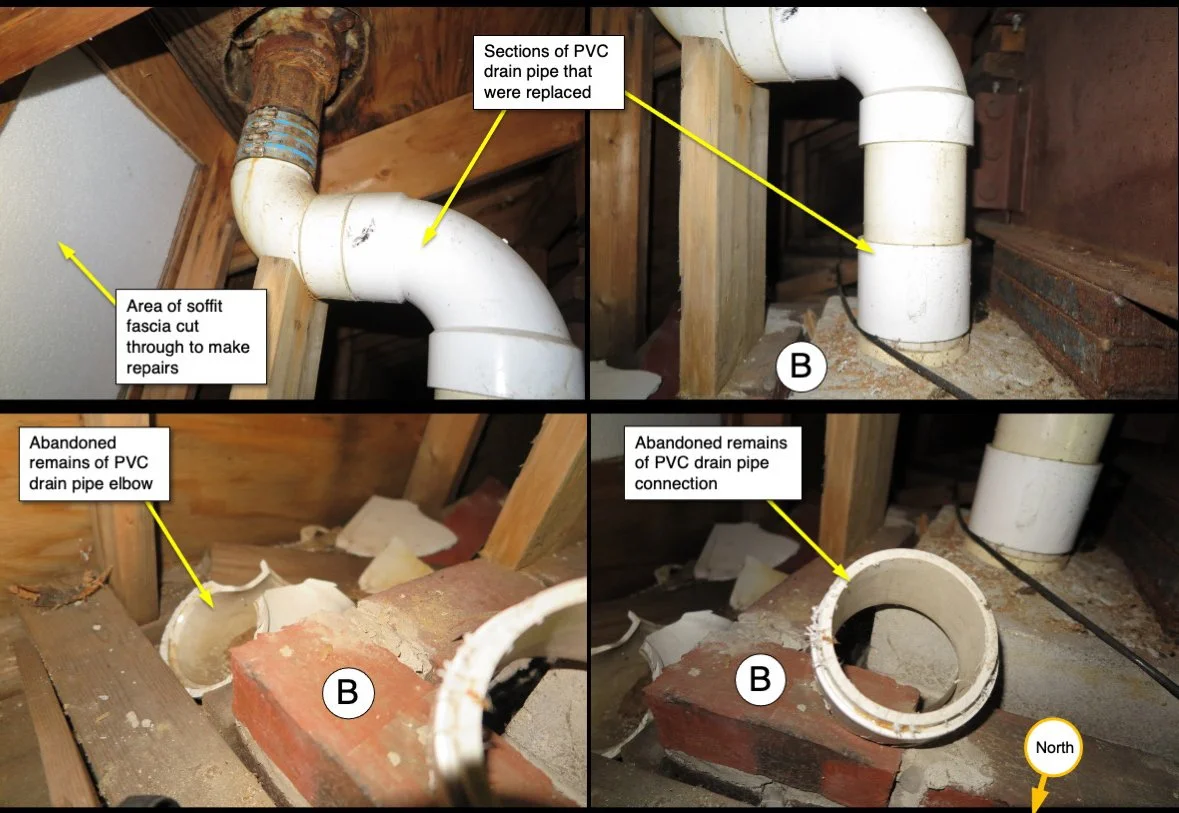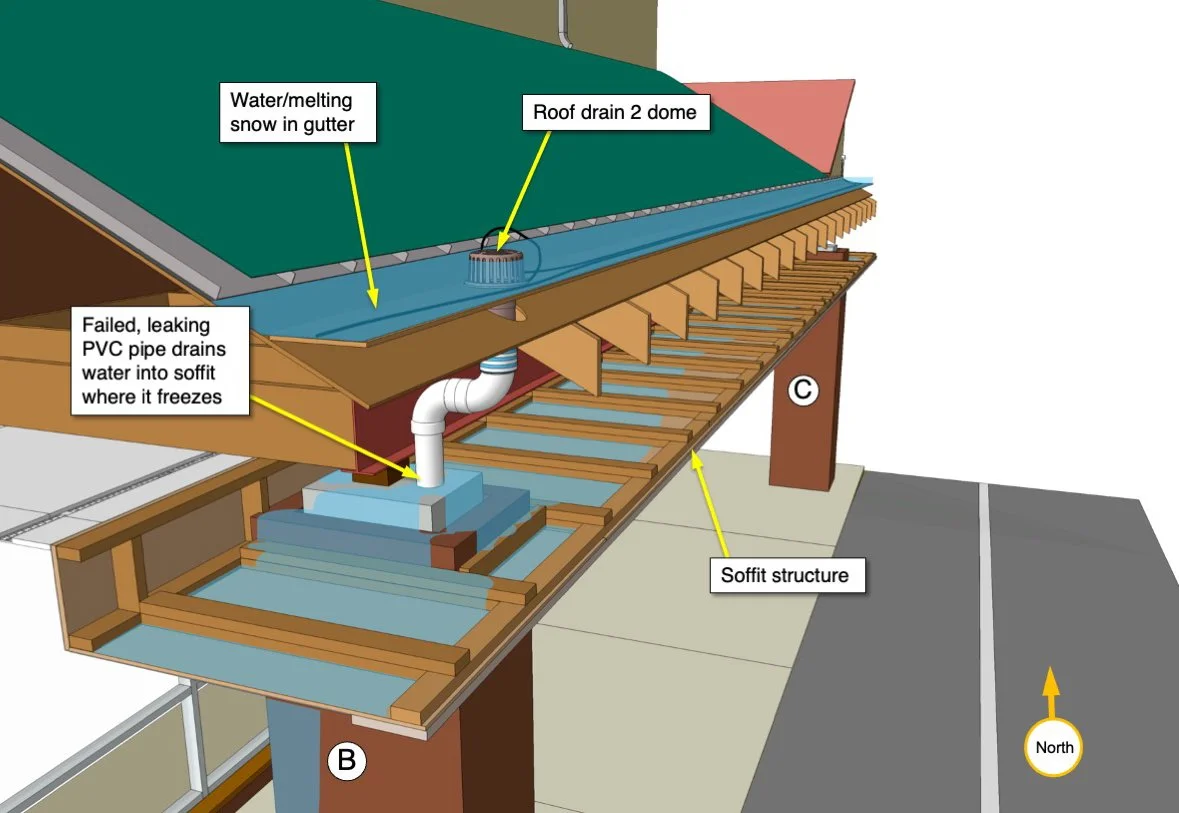A plaintiff sustained serious injuries in a slip-and-fall accident caused by ice buildup in front of a shopping center entrance. Post-accident photos taken by the plaintiff’s attorney documented serious issues with water drainage from the roof in the area of the accident. An internal drain system had failed and caused water to flow through overhead roof structures. The water then leaked onto the sidewalk, forming ice in sub-freezing temperatures. The building had a history of roof leaks from snow and ice accumulating and then melting. Heat tape had been installed to keep water flowing through gutters and internal drainpipes but had failed some months prior to the January accident.
Post-accident photo shows ice conditions on pedestrian walkway and parking lot surface
The Site Inspection Revealed Physical Evidence of the Failure
Drake Exhibits was retained by the plaintiff’s attorney to create graphic exhibits depicting the accident scene. A site inspection was conducted to acquire measurements of the site so that the exhibits produced would be a fair and accurate representation. During the site visit, the interior of the roof overhang was accessed through a ventilation grill. Inside, the PVC drainpipe was visible and had obviously been replaced since the accident. The fractured pieces of the previous drainpipe had been left there by the repair crew – physical evidence the drain had failed and released water inside the roof structure, allowing the ice build-up to occur.
3D model of roof and soffit structure reveals interior drainage system from roof above
Physical Evidence Confirmed the Failure was Caused by Neglect of the Building
A comprehensive reconstruction could have been created solely from architectural drawings and photographs that were part of the file, but the failure mechanism that caused the flow of water throughout the soffit area would not have been discovered without an on-site inspection. The inspection work was initiated a few years after the events that led to the accident. Fortunately, the conditions of the failure were able to be reconstructed from physical evidence. The interior supports for the ceiling structure exhibited a gap that likely resulted from the weight of water and ice on the ceiling panels. Evidence of all the internal repairs made was photographed during the inspection.
Photos of repaired drainpipe and abandoned remains of the failed pipe show evidence of the repair
3D Graphics Illustrated the Building Construction and Failed Piping
Drake Exhibits created a 3D reconstruction of the overhead roof area at the store entrance, including the interior roof structure and overhead soffit. Graphics generated from the 3D model oriented the viewer to the site and showed the details of construction and the mechanism of failure. Illustrations showed the path the water took from the roof gutter to the failed drain pipe through the soffit interior and out to the sidewalk. A separate presentation was created to show the water and weather-related aspects of the failure scenario. This included detailed cross-sections of the drain, water flow, effects of rain volume, and the freeze/thaw cycle that precipitated the failure.
3D model shows water travel through soffit to the area where ice formed, and the plaintiff was injured
Conclusion
In this matter, the scene inspection not only provided the information necessary to create a series of compelling graphics but also led to the discovery of key evidence in support of the plaintiff’s case.
For further reading see the February article about how the 3D model combined with weather data analysis illustrated the expert’s opinion.
-
August 2023
- Aug 2, 2023 Introducing: The Expert Witness, a New Novel Aug 2, 2023
-
June 2023
- Jun 9, 2023 Finite Element Analysis Confirms Thermal Behavior of a Masonry Column Jun 9, 2023
-
April 2023
- Apr 27, 2023 3D Roof Fire Reconstruction Apr 27, 2023
-
March 2023
- Mar 24, 2023 Graphic Diagrams Demonstrate Biomechanics Mar 24, 2023
-
February 2023
- Feb 23, 2023 3D Modeling Combined with Weather Data Analysis Illustrates Expert’s Opinion Feb 23, 2023
-
January 2023
- Jan 25, 2023 Scene Documentation Reveals Evidence of Internal Building Failure Jan 25, 2023
-
August 2022
- Aug 25, 2022 Graphic Reconstruction Proves Theory in a Motor Vehicle Accident - Part Two Aug 25, 2022
-
July 2022
- Jul 20, 2022 Graphic Reconstruction Proves Theory in a Motor Vehicle Accident Jul 20, 2022
-
June 2022
- Jun 15, 2022 Litigation Graphics Strategies Explain a Complicated Loss Jun 15, 2022
-
May 2022
- May 17, 2022 Do I Need a Demonstrative Evidence Expert to Illustrate My Testimony? May 17, 2022
-
April 2022
- Apr 14, 2022 Arc Furnace Failure Illustrated Apr 14, 2022
-
March 2022
- Mar 23, 2022 Fire Litigation Exhibit Options Mar 23, 2022
-
February 2022
- Feb 16, 2022 Gas Explosion Investigation Enhanced by 3D Reconstruction of Building and HVAC System Feb 16, 2022
-
January 2022
- Jan 18, 2022 Scene Reconstruction Illustrates Non-Compliant Furnace Installation that Caused a Fire Jan 18, 2022
- Jan 5, 2022 3D Scene Reconstruction of Cold Storage Facility Serves as a Critical Tool in Fire Investigation Jan 5, 2022




